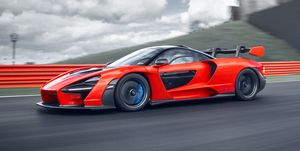- Planned for a debut at the canceled 2020 Geneva auto show is McLaren’s 765LT, the more dynamically focused sibling to the 720S.
- The 765LT makes 754 horsepower and weighs less than 3000 pounds in its lightest configuration.
- First deliveries of the new McLaren are expected in October, at a price around $375,000.
A third of an inch isn’t much. But it’s enough for McLaren to use the Longtail branding the company reserves for the most tuned members of the clan. At the rear, the 765LT, which was to make its debut at the now canceled Geneva auto show, is just 0.4 inch longer than the 720S on which it is based. Don’t worry: there are other changes that are considerably more compelling.
There has never been any doubt that we would see a successor to the 2015 675LT, the turned-up-to-11 version of the 650S. Indeed McLaren CEO Mike Flewitt admitted an LT version of the 720S was in the plan when that car was first shown in 2017. Flewitt’s promises it would be lighter, more powerful, and have sharpened chassis dynamics have all been delivered.
As the 765LT’s name suggests, the power increase over the hugely potent 720S has been relatively modest. McLaren uses metric horsepower rather than corn-fed American units, with 765 PS translating into 754 horsepower. The LT uses the same base 4.0-liter twin-turbo V-8 as the S but gets a higher-capacity fuel pump, forged aluminum pistons, and a three-layer head gasket from the McLaren Senna. It also exhales through a freer-flowing titanium exhaust system featuring a line of four tailpipes, which dominate the rear view of the car and have a large enough caliber to occupy most of the space between the rear lights.
While off-the-line performance will be similar to that of the 720S—the official 2.7-second zero-to-60-mph time is only a tenth faster—the difference becomes more significant at higher speeds. McLaren says the 765LT will be able to get from rest to 124 mph in 7.2 seconds, which is 1.2 seconds inside the 720S’s official time for the same benchmark. Some of the improvement comes from lowered gearing for the seven-speed twin-clutch transmission. McLaren engineers say this has improved in-gear acceleration by 15 percent, at the cost of a slightly lower top speed: 205 mph, achieved in seventh, against the 720S’s 211-mph Vmax in sixth.
Changes on the other side of the 765LT’s balance sheet are even more impressive, with a weight saving of 176 pounds over the 720S, which is already the lightest car in its segment. Achieving McLaren’s claimed 2952-pound curb weight would mean ordering a car in its lightest possible configuration and forgoing both the zero-cost entertainment and air conditioning options. That’s something, McLaren admits, that only a tiny fraction of previous LT model buyers have done. But even with the 25.3-pound penalty to keep both systems factored in, the car is still beneath 3000 pounds in official numbers; for reference, we weighed a fully fueled 720 at 3161 pounds.
Slimming It Down
Mass has been shaved in many areas. McLaren says the 765’s lightweight race seats save 39.7 pounds; the ultralight wheels remove 48.5 pounds; lightweight glazing, including polycarbonate rear side glass, shaves 13.2 pounds; a lightweight battery trims another 13.2 pounds; and the removal of carpet spares 5.3 pounds. Buyers will also be able to remove another 26.5 pounds beyond the headline figure at extra cost by choosing even lighter seats that are pretty much identical to those fitted to the Senna, and also by substituting carbon fiber for aluminum on the hood, door handles, and front and rear fenders.
The overall weight saving was made harder to deliver by the fact some features have actually added mass, including upgraded brakes using the same calipers as the McLaren Senna. Together with an upgraded booster, these add 9.3lbs. Buyers will also be able to upgrade to the Senna’s discs at extra cost, which are claimed to have four times the thermal conductivity of what we must now think of as merely regular carbon ceramics. Using them, McLaren says the 765LT will be able to stop from 124 mph to a standstill in less than 360 feet.
Suspension changes involve a slight (0.2 inch) reduction in front ride height and the use of lightweight main springs with secondary “helper” units, which help to save a modest amount of mass compared to the 720S’s larger dual-rate springs: 3.3 pounds across the car. Spring rates have been increased over the 720S; dampers have also been turned up. The Proactive Chassis Control system that fights roll with laterally linked hydraulic units has also been upgraded to better withstand high-load circuit use. Although tire sizes are unchanged from the 720S—235/35ZR-19 front and 305/30ZR-20 rear—the 765LT will come on track-spec Pirelli Trofeo R rubber as standard.
The 765LT gets a more aggressive aerodynamic package, to both increase its ability to shape and harvest downforce from the passing airflow, but also to demonstrate its superiority over lesser supercars. The vents built into the top of the front fenders are reminiscent of those used by Porsche for the GT2 RS and GT3 RS, with a larger front splitter and a longer active wing element at the rear, these being some of the first components to be manufactured at the company’s newly opened composites factory in Sheffield. While we’re told the LT produces 25 percent more downforce than the 720S, McLaren hasn’t given overall numbers for either car.
Buyers will get a much rawer experience than that delivered by the 720S. The LT loses much of its sister’s noise insulation and has thinner-gauge glass; engine mounts have also been stiffened, something McLaren acknowledges will impact the car’s refinement while boosting performance. We are also promised that the new exhaust system has been designed to create “high-order sound content optimized to create a high-pitched, engaging note that becomes sharper and sharper as it builds.” Good news for those who like their supercars loud and angry.
The 675LT is now regarded as one of the finest early-era McLaren models, and the 600LT was hugely popular in the U.S., where around 500 were sold of both coupe and spider versions. McLaren is going to limit 765LT production to 765 cars globally—the U.S. will likely account for 30 to 40 percent of that total—with the sticker set to be around the $375,000 mark and customer deliveries starting in October.
That’s a very serious price for a very serious car.
Source: Motor - aranddriver.com







